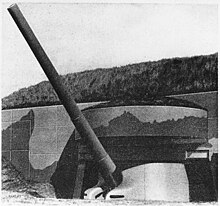
USS Washington (BB-47), a Colorado-class battleship, was the second ship of the United States Navy named in honor of the 42nd state. Her keel was laid down on 30 June 1919, at Camden, New Jersey, by the New York Shipbuilding Corporation. She was launched on 1 September 1921, sponsored by Miss Jean Summers, the daughter of Congressman John W. Summers of Washington.

The Wyoming class was a pair of dreadnought battleships built for the United States Navy. Wyoming and Arkansas were authorized in early 1909, and were built between 1910 and 1912. These were the fourth dreadnought design of the US Navy, but only an incremental improvement over the preceding Florida class, and the last US battleships to use 12-inch guns. The primary changes were the adoption of a more powerful 12 in (305 mm)/50 caliber Mark 7 gun, addition of a sixth twin-gun turret and improved armor protection, including the first use of a torpedo bulkhead on American battleships. The Navy considered using more powerful 14-inch (356 mm) guns, but this would have caused delays and required larger docks.

The Connecticut class of pre-dreadnought battleships were the penultimate class of the type built for the United States Navy. The class comprised six ships: Connecticut, Louisiana, Vermont, Kansas, Minnesota, and New Hampshire, which were built between 1903 and 1908. The ships were armed with a mixed offensive battery of 12-inch (305 mm), 8-inch (203 mm), and 7-inch (178 mm) guns. This arrangement was rendered obsolete by the advent of all-big-gun battleships like the British HMS Dreadnought, which was completed before most of the Connecticuts entered service.

The 16 inch gun M1919 (406 mm) was a large coastal artillery piece installed to defend the United States' major seaports between 1920 and 1946. It was operated by the United States Army Coast Artillery Corps. Only a small number were produced and only seven were mounted; in 1922 and 1940 the US Navy surplussed a number of their own 16-inch/50 guns, which were mated to modified M1919 carriages and filled the need for additional weapons.
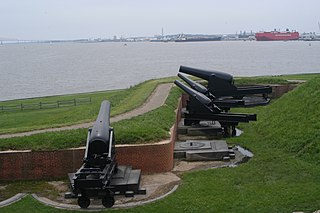
Seacoast defense was a major concern for the United States from its independence until World War II. Before airplanes, many of America's enemies could only reach it from the sea, making coastal forts an economical alternative to standing armies or a large navy. After the 1940s, it was recognized that fixed fortifications were obsolete and ineffective against aircraft and missiles. However, in prior eras foreign fleets were a realistic threat, and substantial fortifications were built at key locations, especially protecting major harbors.

The 4″/50 caliber gun was the standard low-angle, quick-firing gun for United States, first appearing on the monitor Arkansas and then used on "Flush Deck" destroyers through World War I and the 1920s. It was also the standard deck gun on S-class submarines, and was used to rearm numerous submarines built with 3-inch (76 mm) guns early in World War II. United States naval gun terminology indicates the gun fired a projectile 4 inches (100 mm) in diameter, and the barrel was 50 calibers long.
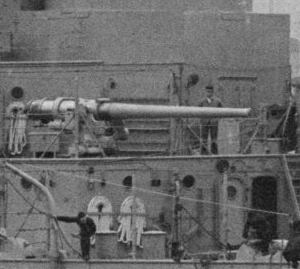
5"/51 caliber guns initially served as the secondary battery of United States Navy battleships built from 1907 through the 1920s, also serving on other vessels. United States naval gun terminology indicates the gun fired a projectile 5-inch (127 mm) in diameter, and the barrel was 51 calibers long.

Fort Duvall was a Coast Artillery fort, part of the Harbor Defenses of Boston, in Massachusetts. What was then called Hog Island in Hull, Massachusetts was acquired by the U.S. government in 1917, and the fort was constructed in the early 1920s. It had only one gun battery, Battery Long, but it mounted the largest caliber weapons in the entire harbor defense system: a pair of 16-inch guns. These were the 16-inch gun M1919, of which only seven were deployed; 16-inch weapons deployed later were supplied by the Navy.
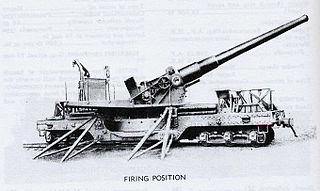
The 8-inch Navy gun Mk.VI M3A2 on railway mount M1A1 was a World War II improved replacement for the World War I-era 8-inch M1888 gun and was used by the US Army's Coast Artillery Corps in US harbor defenses. The guns were also mounted in fixed emplacements on the barbette carriage M1A1. These guns were US Navy surplus 8"/45 caliber guns from battleships scrapped under the 1922 Washington Naval Treaty. Mark VI was the Navy designation. The Army designation for this gun was "8-inch Navy gun Mk.VI M3A2".

The U.S. Army Coast Artillery Corps (CAC) was an administrative corps responsible for coastal, harbor, and anti-aircraft defense of the United States and its possessions between 1901 and 1950. The CAC also operated heavy and railway artillery during World War I.

The 12-inch coastal defense gun M1895 (305 mm) and its variants the M1888 and M1900 were large coastal artillery pieces installed to defend major American seaports between 1895 and 1945. For most of their history they were operated by the United States Army Coast Artillery Corps. Most were installed on disappearing carriages, with early installations on low-angle barbette mountings. From 1919, 19 long-range two-gun batteries were built using the M1895 on an M1917 long-range barbette carriage. Almost all of the weapons not in the Philippines were scrapped during and after World War II.

The 10-inch Gun M1895 (254 mm) and its variants the M1888 and M1900 were large coastal artillery pieces installed to defend major American seaports between 1895 and 1945. For most of their history they were operated by the United States Army Coast Artillery Corps. Most were installed on disappearing carriages, with early installations on barbette mountings. All of the weapons not in the Philippines were scrapped during World War II. Two of the surviving weapons were relocated from the Philippines to Fort Casey in Washington state in the 1960s.
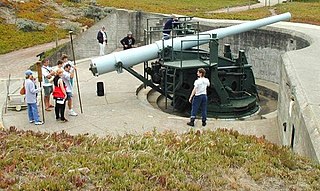
The 6-inch gun M1897 (152 mm) and its variants the M1900, M1903, M1905, M1908, and M1 were coastal artillery pieces installed to defend major American seaports between 1897 and 1945. For most of their history they were operated by the United States Army Coast Artillery Corps. They were installed on disappearing carriages or pedestal mountings, and during World War II many were remounted on shielded barbette carriages. Most of the weapons not in the Philippines were scrapped within a few years after World War II.

The 8"/45 caliber Mark 6 gun were used for the secondary batteries of the United States Navy's last pre-dreadnought battleships and refitted in older armored cruisers main batteries.

The 7"/44 caliber gun Mark 1 and 7"/45 caliber gun Mark 2 were used for the secondary batteries of the United States Navy's last generation of pre-dreadnought battleships, the Connecticut-class and Mississippi-class. The 7-inch (178 mm) caliber was considered, at the time, to be the largest caliber weapon suitable as a rapid-fire secondary gun because its shells were the heaviest that one man could handle alone.

The 4"/40 caliber gun was used for the secondary batteries on the United States Navy's battleship Iowa, Columbia-class protected cruisers, and the armored cruiser New York, and was the primary batteries on the gunboats Nashville, Wilmington, and Helena.

The 5"/50 caliber gun was the first long barrel 5-inch (127 mm) gun of the United States Navy and was used in the secondary batteries of the early Delaware-class dreadnought battleships, various protected cruisers, and scout cruisers. They were also refitted in the secondary batteries of the armored cruiser New York and the New Orleans-class protected cruisers. They were later used on cargo ships, store ships and unclassified auxiliaries during World War II as well as in emergency coastal defense batteries.

The 6"/50 caliber gun Mark 6 and Mark 8 were used for the secondary batteries of the United States Navy's Maine-class and Virginia-class battleships, as well as the Pennsylvania-class and Tennessee-class armored cruisers. They were also used as the main battery on the St. Louis-class protected cruisers.

The 16-inch howitzer M1920 (406 mm) was a coastal artillery piece installed to defend major American seaports between 1922 and 1947. They were operated by the United States Army Coast Artillery Corps. They were installed on high-angle barbette mountings to allow plunging fire. Only four of these weapons were deployed, all at Fort Story, Virginia. All were scrapped within a few years after World War II.


